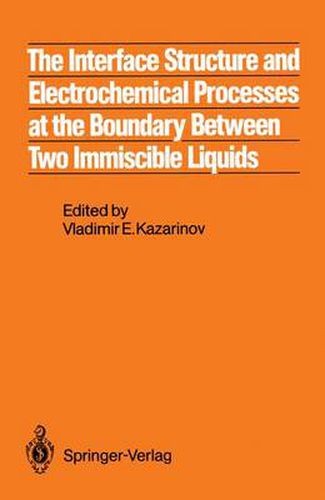Readings Newsletter
Become a Readings Member to make your shopping experience even easier.
Sign in or sign up for free!
You’re not far away from qualifying for FREE standard shipping within Australia
You’ve qualified for FREE standard shipping within Australia
The cart is loading…






This title is printed to order. This book may have been self-published. If so, we cannot guarantee the quality of the content. In the main most books will have gone through the editing process however some may not. We therefore suggest that you be aware of this before ordering this book. If in doubt check either the author or publisher’s details as we are unable to accept any returns unless they are faulty. Please contact us if you have any questions.
Studies on the electrochemical processes at the interface between two immiscible liquids began a long time ago: they date back to the end of the last century. Such celebrated scientists as Nemst and Haber, and also young A. N. Frumkin were among those who originated this science. Later A. N. Frumkin went a long way in furthering the studies at the Institute of Electrochemistry. The theory of the appearance of potential in a system of two immiscible electrolytes was developed and experimentally verified before the beginning of the thirties. In later years the studies in this area considerably lagged behind those conducted at metal electrodes which were widely used in different industries. In the past 15 years, however, the situation has radically changed and we have witnessed a drastic increase in the number of publications on the electrochemistry of immiscible electrolytes. We are glad to note that the investiga tions show not only a quantitative but also a qualitative change. The theoretical works on the oil/water interface test not only the thermodynamic aspects of the inter face but also recreate the molecular picture of the process. Along with the now con ventional oilfwater system, electrochemical studies are made on various membranes, including the frnest bilayer lipid membranes, and also on microemulsion systems. A prominent place in the investigation of the oil/water interface is occupied by photoprocesses that come into play at the interface between two ionic conductors.
$9.00 standard shipping within Australia
FREE standard shipping within Australia for orders over $100.00
Express & International shipping calculated at checkout
Stock availability can be subject to change without notice. We recommend calling the shop or contacting our online team to check availability of low stock items. Please see our Shopping Online page for more details.
This title is printed to order. This book may have been self-published. If so, we cannot guarantee the quality of the content. In the main most books will have gone through the editing process however some may not. We therefore suggest that you be aware of this before ordering this book. If in doubt check either the author or publisher’s details as we are unable to accept any returns unless they are faulty. Please contact us if you have any questions.
Studies on the electrochemical processes at the interface between two immiscible liquids began a long time ago: they date back to the end of the last century. Such celebrated scientists as Nemst and Haber, and also young A. N. Frumkin were among those who originated this science. Later A. N. Frumkin went a long way in furthering the studies at the Institute of Electrochemistry. The theory of the appearance of potential in a system of two immiscible electrolytes was developed and experimentally verified before the beginning of the thirties. In later years the studies in this area considerably lagged behind those conducted at metal electrodes which were widely used in different industries. In the past 15 years, however, the situation has radically changed and we have witnessed a drastic increase in the number of publications on the electrochemistry of immiscible electrolytes. We are glad to note that the investiga tions show not only a quantitative but also a qualitative change. The theoretical works on the oil/water interface test not only the thermodynamic aspects of the inter face but also recreate the molecular picture of the process. Along with the now con ventional oilfwater system, electrochemical studies are made on various membranes, including the frnest bilayer lipid membranes, and also on microemulsion systems. A prominent place in the investigation of the oil/water interface is occupied by photoprocesses that come into play at the interface between two ionic conductors.